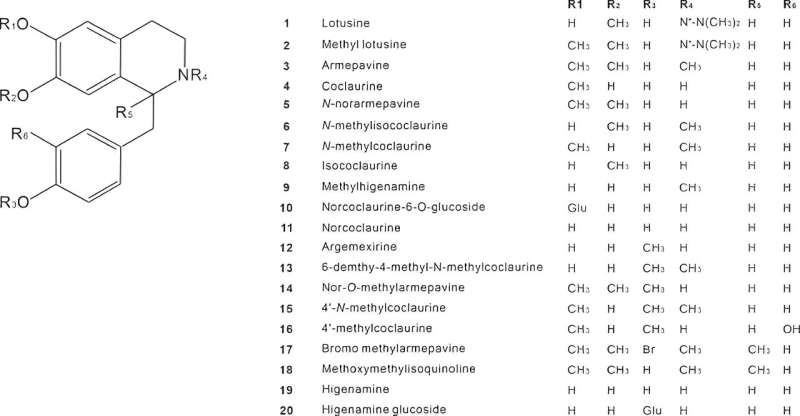This article has been reviewed according to Science X's editorial process and policies. Editors have highlighted the following attributes while ensuring the content's credibility:
fact-checked
trusted source
proofread
Researchers explore medicinal potential of lotus benzylisoquinoline alkaloids

A research team has made progress in understanding benzylisoquinoline alkaloids (BIAs) in lotus (Nelumbo nucifera), highlighting their presence in various tissues and their potential for novel drug development.
The team's review covers chemical profiling, extraction methods, pharmacological activities, and biosynthesis of lotus BIAs, noting the identification of 59 BIAs, with a focus on their accumulation in leaves and plumules. The review underscores the importance of these compounds in treating life-threatening diseases, such as obesity, inflammation, cancer, HIV, and aniocardiopathy, and outlines the need for future research in the functional characterization of biosynthetic pathways and structural modifications of BIAs.
This work not only deepens our understanding of lotus BIAs, but also lays a foundation for its application to create effective clinical drugs and solves the urgent need for the treatment of degenerative disease and new infections.
Lotus (Nelumbo nucifera), commonly known as the Asian lotus, holds significant commercial and cultural value. Lotus is rich in benzylisoquinoline alkaloids (BIAs) in almost all tissues and has great potential for developing new drugs to prevent and treat a variety of life-threatening diseases. However, it is still a challenge to optimize the extraction of these compounds, explore their pharmacological potential and elucidate their biosynthetic pathways.
Addressing these challenges, a study published in Vegetable Research provides a comprehensive summary on the up-to-date advances in the study of lotus BIAs.
Researchers have methodically advanced our understanding of the biosynthesis, chemical profiling, extraction methods, and pharmacological activities of BIAs in the lotus plant. Their findings reveal that lotus plants are enriched in more than 61 BIAs, predominantly classified into the 1-benzylisoquinoline, aporphine, and bis-BIA categories, with significant accumulation in leaves and plumules, and presenting a unique predominance of R-conformers in contrast to the S-conformers commonly found in the Ranunculales order.
Some BIAs such as nuciferine and anonaine showing significant pharmacological potential. Extraction methods such as supercritical fluid extraction and high-speed counter-current chromatography increase yields and purity.
High-performance liquid chromatography combined with electrospray ionization and tandem mass spectrometry remains the gold standard for BIA separation, quantification and characterization. Pharmacological studies of these compounds have highlighted their potential in the treatment of various diseases ranging from obesity to cancer due to their multiple biological activities.
Furthermore, the dynamic accumulation of BIAs in lotus has been intricately studied, and the results showed that there were significant differences in BIA content at different developmental stages and among different lotus cultivars.
Based on the isolation and functional characterization of the biosynthetic genes, the key biosynthetic pathways of BIAs in lotus were proposed, revealing the crucial steps from tyrosine conversion to the formation of complex BIA structures.
The regulation of these pathways and the transcriptional mechanisms governing BIA biosynthesis have been explored, indicating a sophisticated control system influenced by mechanical wounding and jasmonate treatment.
According to the study's senior researcher, Prof. Xianbao Deng, "This review provides a comprehensive summary on the up-to-date advances in the chemical profiling, extraction methods, pharmacological activities, and biosynthesis of lotus BIAs."
This comprehensive research not only enriches our understanding of the lotus BIAs but also opens avenues for future research and potential clinical applications, including the development of novel drugs targeting life-threatening human diseases.
More information: Xue Wei et al, Lotus ( Nelumbo nucifera) benzylisoquinoline alkaloids: advances in chemical profiling, extraction methods, pharmacological activities, and biosynthetic elucidation, Vegetable Research (2024). DOI: 10.48130/vegres-0024-0004
Provided by Chinese Academy of Sciences





















